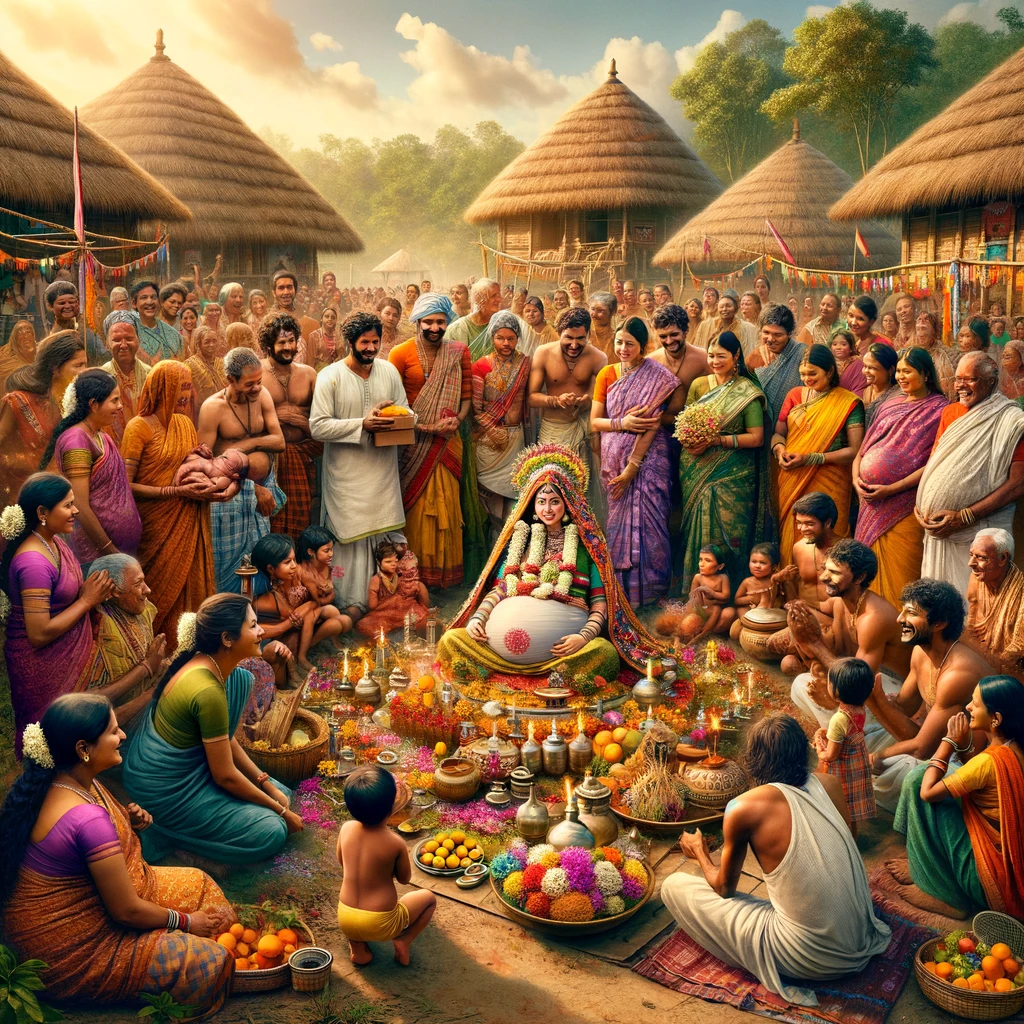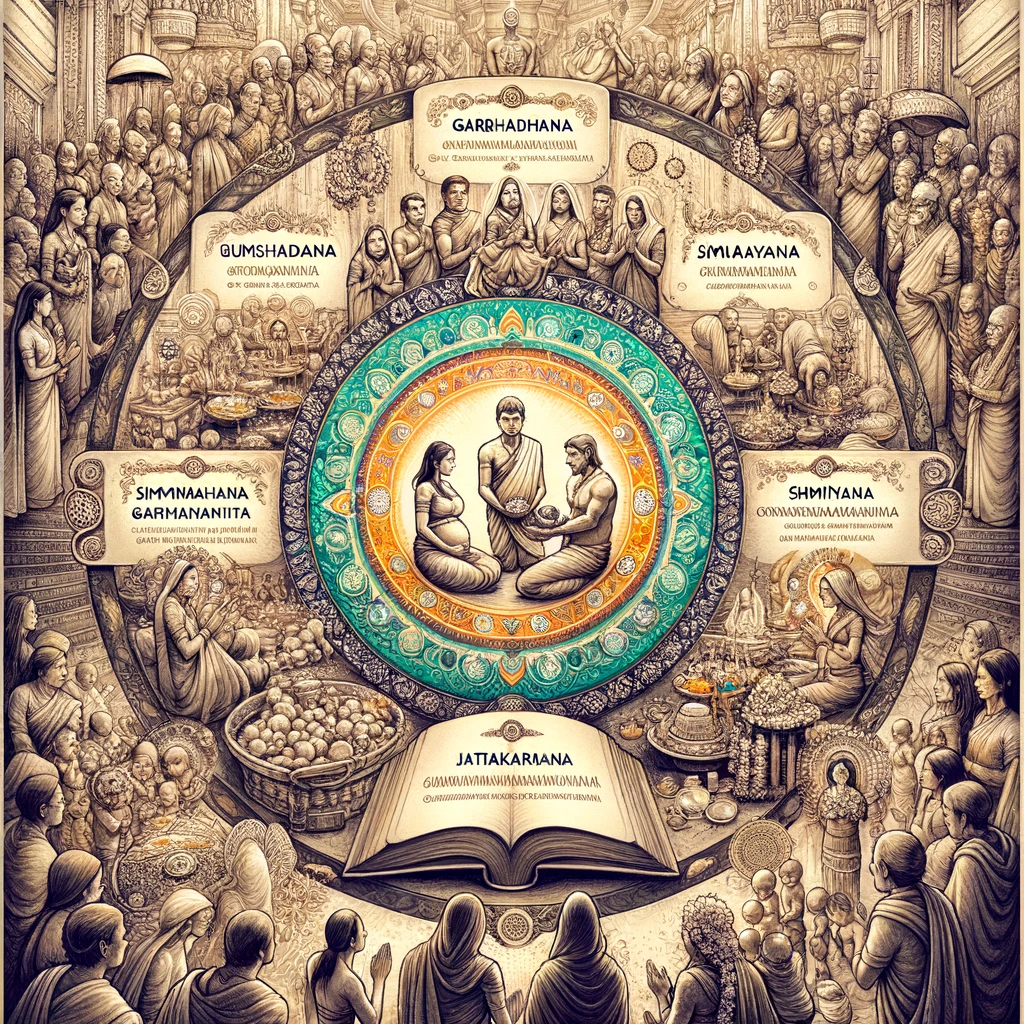Sixteen Sanskaras: A Global and Historical Perspective
From Birth to Enlightenment: Sixteen Sanskaras Impact
Our initial focus on the first four Sanskaras will introduce readers to the profound beginnings of life’s journey as envisaged in Hindu philosophy. From the preparatory rites that welcome a new soul into the world to the celebratory ceremonies that mark early childhood milestones, these initial Sanskaras lay the spiritual and communal groundwork for the individual’s life. As we prepare to embark on this exploratory series, we invite readers to reflect on the universal themes of growth, responsibility, and transcendence that these ancient rites embody, setting the stage for a deeper understanding of the remaining Sanskaras in future post.
Worldwide Influence: Sixteen Sanskaras Impact:
The Sanskaras, pivotal to Hindu spiritual practice, have not only nurtured the faith’s continuity across generations but have also showcased their global relevance in today’s diverse world. They offer a structured approach to life’s transitions, deeply rooted in spiritual tradition, yet remarkably adaptable, reflecting Hinduism’s ability to sustain and grow through various historical epochs. This resilience is particularly notable in how these practices helped Hindu communities maintain their cultural identity amidst centuries of foreign rule and cultural exchanges, illustrating the Sanskaras’ intrinsic power to bind communities.
Unlike other traditions, where rituals marking life’s milestones may be minimal, the comprehensive nature of the Sanskaras has contributed significantly to the preservation of Hindu identity. Their role in fostering community cohesion and spiritual continuity became a bastion of resilience during periods of adversity. For instance, the enduring strength of these rituals supported Hindu society through the challenges of Islamic rule in India, where, despite prolonged efforts to convert the population, the community’s faith and practices remained largely intact. This stands in stark contrast to the rapid conversions witnessed in regions like Persia, Syria, and Lebanon, highlighting the Sanskaras’ importance in sustaining Hindu culture.
Today, the Sanskaras continue to resonate with Hindus worldwide, adapting to new contexts while preserving their core principles. This adaptability speaks to their universal appeal, transcending cultural and geographical boundaries to offer meaningful guidance for life’s journey. As we delve into the Sanskaras’ significance, we uncover not just the rituals themselves but the profound sense of belonging and identity they foster, ensuring the continuity of Hindu tradition in the face of changing times.
Sixteen Sanskaras Impact on Spirituality and Science
In the realm of Hindu practices, the fusion of spirituality with empirical science reveals a profound understanding of human well-being and environmental stewardship. This section highlights how ancient rituals like Yoga, Pranayama, and environmental rituals align with contemporary scientific findings, underscoring the timeless relevance of these practices.
Yoga and Pranayama: Scientific and Communal Benefits
The Science of Well-being – Celebrated for their holistic benefits, Yoga and Pranayama are not just spiritual exercises but are supported by scientific research in enhancing physical and mental health. Studies in journals like ‘The Journal of Alternative and Complementary Medicine’ validate the benefits of these practices in reducing stress, improving cardiovascular health, and enhancing lung capacity. These findings echo the communal aspects of Yoga and Pranayama, where group practice fosters not only individual well-being but also communal harmony.
Surya Namaskar: Aligning Body and Nature

Aligning with Nature’s Rhythm – The practice of Surya Namaskar, beyond its physical benefits, is a manifestation of syncing human biological rhythms with the natural cycle. Research highlighted in the ‘International Journal of Yoga’ supports its role in enhancing sleep quality and overall wellbeing, demonstrating how communal practice at dawn harmonizes personal health with cosmic cycles.
Namakarana: The Science and Significance of Naming
The Influence of Names – The Namakarana ceremony, emphasizing the significance of naming, finds its validation in psychological studies, such as those published in ‘Social Psychological and Personality Science’, which illustrate how names impact an individual’s social interactions and personality development. This ritual, a collective celebration, highlights the scientific underpinnings of cultural practices in shaping identity.
Fasting in Hinduism: Health and Communal Unity
Health and Empathy – Fasting, integral to Hindu spirituality, is corroborated by modern health science as beneficial for metabolism and longevity. Studies in ‘The American Journal of Clinical Nutrition’ show fasting’s role in promoting health, while communal fasting practices underscore the shared experience of discipline and empathy among practitioners.
Environmental Stewardship: Hinduism and Nature Conservation
Cultivating Respect for Nature – Hindu environmental rituals, predating but aligning with modern conservation efforts, emphasize a communal respect for nature. Research in ‘Conservation Biology’ supports the notion that cultural practices can significantly contribute to environmental sustainability, showcasing the Sanskaras’ role in fostering ecological consciousness.
Through the lens of modern science, the Sanskaras reveal a remarkable alignment between ancient wisdom and contemporary understanding. This synthesis of spirituality and science not only validates the health and communal benefits of these practices but also highlights the Sanskaras’ role in promoting a balanced and mindful approach to life.
As we explore these scientific perspectives, the Sanskaras stand out not merely as religious rituals but as practices enriched with deep ecological, psychological, and physiological insights. They exemplify a holistic approach to living that seamlessly blends spiritual pursuit with scientific understanding, fostering well-being on both individual and communal levels.
Personal Tales: Sixteen Sanskaras Impact in Today’s World
In the vibrant mosaic of Hindu traditions, the Sanskaras are not mere rituals; they are experiences deeply woven into the fabric of life, enriched by personal stories and community celebrations. These narratives shine a light on the Sanskaras’ profound impact on both individuals and communities.
Garbhadhana in Mumbai: Tradition Meets Modernity

(https://hinduinfopedia.in/wp-content/uploads/2024/03/Garbhadhana_ceremony_Mumbai_2.webp)
Consider Avinash and Meera’s journey in Mumbai. Opting for the Garbhadhana ceremony amidst the urban hustle, they found a moment of profound connection to their roots. This ceremony, attended by family and friends, transcended traditional ritual to become a celebration of new beginnings, illustrating the Sanskaras’ relevance in modern urban settings.
Communal Bonds in Odisha: Pumsavana and Simantonayana

(https://hinduinfopedia.in/wp-content/uploads/2024/03/Rural_Odisha_India_Pumsavana.webp)
Kavita’s story from rural Odisha highlights the nurturing aspect of the Pumsavana and Simantonayana ceremonies. With the entire village participating, these rites transformed into a communal embrace, offering support and blessings for her and her unborn child. This illustrates the Sanskaras’ ability to forge a supportive community network, crucial in areas where modern amenities are scarce.
Sanskaras Today: Adapting Ancient Traditions
These stories—from the bustling streets of Mumbai to the serene villages of Odisha—reveal the enduring vitality of the Sanskaras. They underscore the adaptability of these traditions, as they seamlessly integrate into the lives of those who practice them, fostering a sense of community and continuity.
Personal Stories: Impact of Sixteen Sanskaras
Avinash, Meera, and Kavita’s experiences illuminate the Sanskaras’ significance beyond the rituals. It is in these personal journeys that the essence of the Sanskaras truly shines—binding families, enriching communities, and bridging generations.
Community’s Role in the Sixteen Sanskaras And Their Impact
From cityscapes to rural settings, the Sanskaras foster an intricate web of support and shared values. These stories exemplify how community involvement is central to each ceremony, reinforcing the social fabric that sustains Hindu traditions.
Balancing Tradition and Modernity in Sixteen Sanskaras
Through the lens of these personal stories, we witness the dynamic interplay between tradition and modernity. The Sanskaras, while deeply rooted in ancient wisdom, continue to evolve, resonating with individuals across different backgrounds and lifestyles.
Future of the Sixteen Sanskaras: A Forward Look
As we delve further into the exploration of the Sanskaras, it’s the personal narratives that enrich our understanding, connecting ancient rites to contemporary life. These stories not only celebrate the resilience and adaptability of the traditions but also highlight the communal spirit that is intrinsic to the Hindu way of life.
Communal Foundations: Sixteen Sanskaras Impact in Early Stages
Garbhadhana: A Communal Welcome
The Garbhadhana ceremony, marking the commencement of life’s journey, is deeply rooted in communal support. This rite is not merely a familial affair but a celebration of potential life that involves the entire community. As families gather to perform this ceremony, they collectively seek blessings for the couple, emphasizing the community’s role in fostering a nurturing environment from the very beginning of a person’s existence. This collective ritual underscores the belief that life’s journey is supported by the goodwill and prayers of everyone, laying the foundation for the child’s future within a circle of love and care.
Pumsavana: Prayers for the Unborn
During the Pumsavana ceremony, focused on the well-being of the unborn child, the palpable presence of the community illustrates the profound belief in the power of collective goodwill. The community’s participation, through shared rituals and prayers, aims to protect and nurture the developing life, showcasing the community’s integral role in the child’s early stages. This ceremony exemplifies how communal support extends beyond physical presence, embodying a collective wish for health and prosperity that surrounds and uplifts the expecting family.
Simantonayana: Celebrating Expectancy
The Simantonayana ceremony, akin to a contemporary baby shower, is a vivid example of community joy and anticipation for the forthcoming birth. It is a moment where family and friends unite to shower the expectant mother with blessings, gifts, and emotional support. This celebration goes beyond preparing for the arrival of a new member; it reinforces the bonds of community, highlighting the shared excitement and collective support that envelops the family, reminding them that they are not alone in their journey.
Jatakarman: The Newborn’s Communal Welcome
In the Jatakarman ceremony, conducted soon after birth, the newborn is introduced to the world surrounded by communal blessings. This ceremony is a significant communal event, not just for the family but for the entire community, as they come together to celebrate the arrival of new life. It signifies the communal commitment to the welfare and spiritual journey of the newborn, reinforcing the idea that the child’s growth and development are a collective responsibility.
Strengthening Ties: Communal Rituals in the Sixteen Sanskaras
These ceremonies—from conception to the initial steps into the world—illustrate the profound integration of community support within the fabric of Hindu life. Each Sanskara, enriched by the active participation and blessings of the community, highlights the essential belief in the collective journey of growth, well-being, and spiritual development. Through these rituals, we observe not just the individual’s transition through life’s stages but also the deepening of communal ties, emphasizing that the journey through the Sixteen Sanskaras is a shared experience, nurtured by the strength and unity of the community.
Closing Insights: Sixteen Sanskaras Impact Summary
As we conclude our exploration of the initial phase of the Sixteen Sanskaras, we’ve journeyed through the profound rites that mark the beginning of life, from conception to the early years of childhood. These ceremonies, rich in symbolic and communal significance, extend beyond mere tradition to embody the seamless integration of spiritual and communal values within the fabric of Hindu life. They serve as the foundational pillars for an individual’s journey, enveloping them in a web of communal support and spiritual guidance from the very outset.
Our exploration has illuminated the intricate ways in which these ancient rites of passage not only guide the individual’s spiritual and physical journey but also fortify the bonds of community. Each ceremony, from Garbhadhana to Jatakarman, is imbued with collective aspirations, prayers, and blessings, highlighting the communal fabric that underlies Hindu cultural heritage. These initial Sanskaras set the stage for a life journey deeply intertwined with the community, ensuring that no significant transition is navigated in isolation.
Anticipating the Next Steps in the Sixteen Sanskaras
This exploration, while focused on the first four Sanskaras, merely scratches the surface of the profound spiritual odyssey charted by the Sixteen Sanskaras. The insights gleaned from this initial exploration not only deepen our appreciation for Hindu cultural practices but also underscore the universal themes of growth, responsibility, and community that resonate with the human experience at large.
As we anticipate further exploration of the remaining Sanskaras, we look forward to uncovering how these rites of passage continue to guide the individual through learning, societal engagement, retirement, and the ultimate transition beyond life. The journey through the Sixteen Sanskaras, rich with tradition, wisdom, and communal bonds, offers invaluable lessons on living a life of meaning, connection, and purpose, enriched by the strength and support of the community.
Thus, as we close this chapter of our exploration, we do so with a sense of fulfillment and anticipation, ready to embark on the next phase of our journey through the Sanskaras. Our exploration of these sacred rites, rooted in the past yet vibrantly alive in the present, invites us to reflect on our own paths and the communities that shape and support us, reminding us of the shared journey we all undertake through the tapestry of life.
Feature Image: The image presents a detailed and intricate illustration portraying a scene steeped in Hindu cultural and spiritual symbolism. At the center, an ancient Hindu scripture is open, with its contents radiating light and knowledge. Surrounding this central focal point are four significant Sanskaras or Hindu life-cycle rituals, depicted in their traditional ceremonial context. These are Garbhadhana (conception), Pumsavana (fetus protection), Simantonnayana (hair parting), and Jatakarma (birth ceremony). Each Sanskara is indicated by its own labeled panel, adding a narrative element to the visuals. The surrounding crowd, comprised of diverse figures representing the community, watches and participates, highlighting the communal nature of these rites. The detailed artistry and monochromatic tone evoke a sense of ancient tradition and communal reverence. (For Image Click Here)
Related Posts
